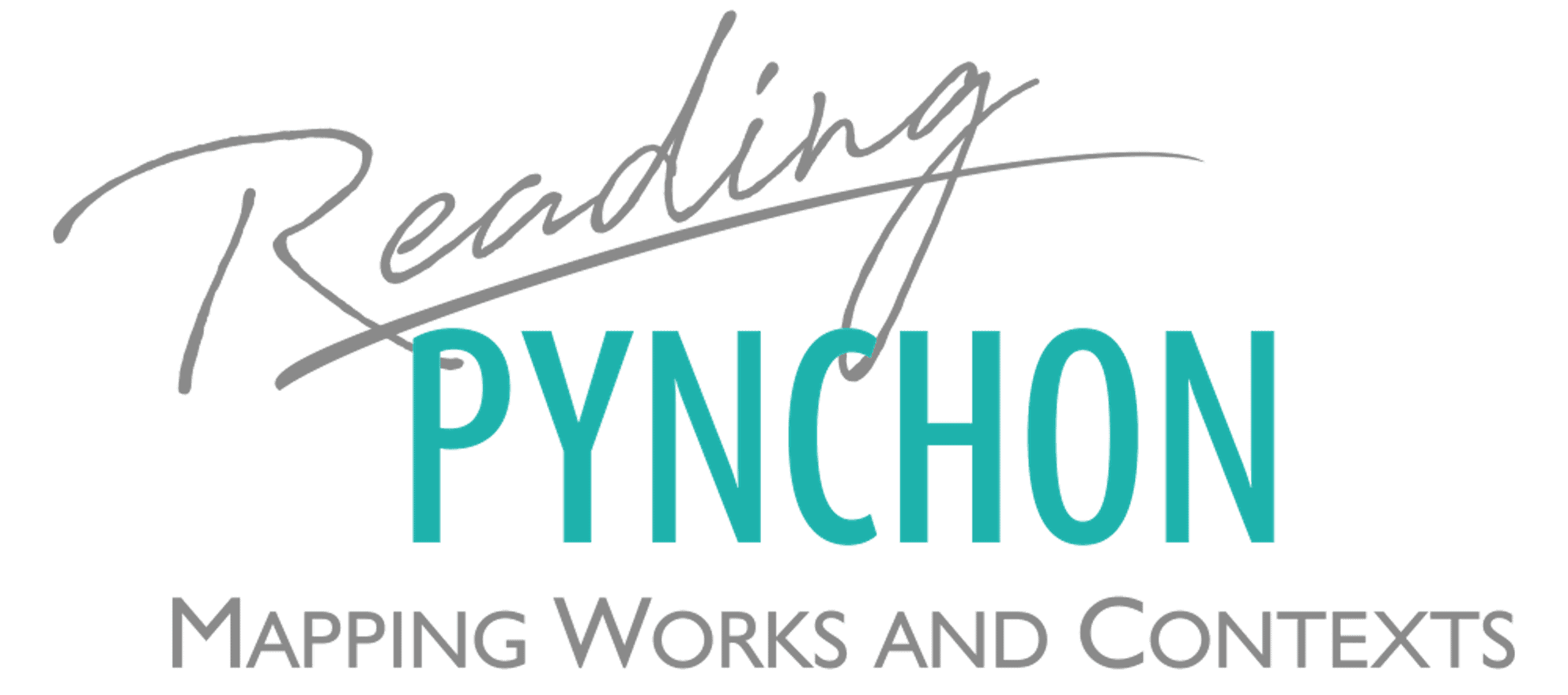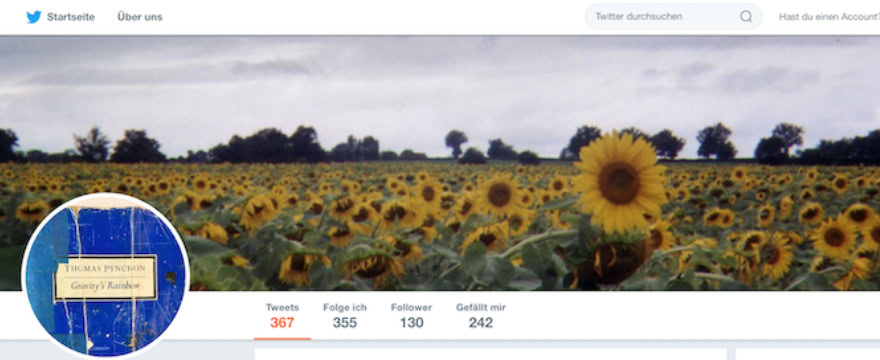Dem Dichter ergeht es genauso wie einem Musiker, der von vier Stimmen einen Gesang singen lässt, in dem zuerst der Sopran, dann der Tenor, darauf der Alt und nach ihm der Bass singt […].
Leonardo da Vinci, between 1495-1499 / 1990: 142
The poet is like a musician who lets four voices sing a song in which first the soprano, then the tenor, followed by the alto, and then the bass sings.
Leonardo da Vinci, between 1495-1499 / 1990: 142 (translated by Utz Klöppelt)
Musical sketches of Gravity’s Rainbow
Is Pynchon like the poet Leonardo evokes? Is Edward Bennett, composer of Gravity’s Rainbow scored page for page like the musician in the Renaissance painter’s quote above?
Can we “translate” words into music? Can we translate textual complexity, atmosphere, and themes into music?
Whatever the answers to these questions – there is no doubt that Edward Bennett has started an interesting, funny, original, addictive, and complex project: writing musical sketches based on single sentences from Thomas Pynchon’s Gravity’s Rainbow and thus creating a parallel musical universe to Pynchon’s novel, almost like Zak Smith (see Smith 2006) did before with drawings for each page of Gravity’s Rainbow.
You can find Bennett’s musical sketches on Twitter. In a sticky post to his project’s Twitter account, he writes:
Hello. I received permission some years ago from Pynchon’s publisher in New York to score Gravity’s Rainbow page for page. I have scored roughly half of the Penguin edition, so I will begin posting sound impressions page by page, starting 3/12/2018.
Bennett 2018
Homages to Pynchon in music, visual images, and on film are numerous, consider Laurie Anderson’s “Gravity’s Angel” (1984), Zak Smith’s drawings (2006), or Robert Bramkamp’s Prüfstand 7 featuring scenes from Thomas Pynchon’s Gravity’s Rainbow (2002).
Edward Bennett has added his personal contribution to that list – listen to it on Twitter and read more about him and his project in the interview below!
Interview with Edward Bennett
Edward Bennett and his idea for the project
Reading Pynchon: Please, tell us about yourself!
Edward Bennett: My background is in nutritional anthropology and foodborne disease epidemiology. I became interested in sound ecology and design within Ableton Live near the start of the 21st century. I write, read, and compose daily in between working as an agriculturalist, makerspace educator, husband, and father.
Reading Pynchon: When did you decide to start working on Gravity’s Rainbow scored page for page?
Edward A. Bennett: I started the project back in 2004 after securing permission from Pynchon’s New York Publisher for the 760-page blue-cover V2-diagram Penguin edition. I asked and received permission back when I lived in Menahan, New York […] having finished the book for the first time, and after being inspired by Zak Smith’s visual tackle of Pynchon’s epic.

[…] I decided to approach a word; a passage; an idea; an equation – each page as a springboard for an audio sketch with zero allegiance to any particular genre […].
Edward Bennett
Shortly afterwards I moved to a rural fishing village outside of Matsue in Japan. I did not speak Japanese, and I did not know anything about audio-engineering, so I decided to teach myself both (using the German-based Ableton Live as my digital audio workstation).
That was the start of the project, but it always seemed too daunting to conquer and took some time to take shape. After several false starts, I decided to approach a word; a passage; an idea; an equation – each page as a springboard for an audio sketch with zero allegiance to any particular genre; an opportunity to explore multiple approaches to sound synthesis, field recording, studio recording, sampling, experimentation, and failure.
Finding form and medium
Reading Pynchon: How did the project evolve? And why did you decide to publish it via Twitter?
Edward Bennett: I ended up with working on the project over the years with specific pages in mind that became the starting point for musical projects ranging from mere seconds to several minutes, some of which would become more structured “songs” that drew the interest of several female and male vocalists in the places I’ve lived.
I tried several times to find the right way to disseminate the project, but I never found the right digital medium for such an odd obsessive project. I didn’t really want to draw attention to the project until I reluctantly tried Twitter and found its cold character limitations to be a complimentary platform for juxtaposing textual detail that inspired a piece along with a tinyurl link to an mp3 hosted on my server. I still have no real understanding of how Twitter works, but the character limits are just shy of the ~4 line limit Penguin gave me for copying Pynchon’s text without direct attribution. I haven’t tagged the most recent material (the last 30 or so uploads), but I bulk edit the metadata in the mp3s to include who is singing what vocals and noting the attribution/share-share alike/ask artist permission for commercial use copyright permissions as time allows.
The book has helped force me to explore within the limitations of what’s in a given sentence subtracted by degrees from what came the page before […].
Edward Bennett
Reading Pynchon: Please describe your project!

Edward Bennett: This is a project with no purpose other than to reach completion, work on composition, practice lyrical wordplay, learn more about sound engineering, pay homage to Pynchon, and provide an aural guide to people struggling to make it through the book. All of the songs are hosted on my server at www.newcolonies.com (the name of my last band), each song is the three digit page number that is its namesake (003, 098, 176, 654, …), they are posted sequentially on Twitter from oldest to newest, some pages are skipped in most instances where there is a blank page or no listed page number, and the songs do follow the plot(s) of the book (leitmotifs and lyrics build on themselves, reference themselves, and make fun of themselves).
Words and music – How to translate textual complexity into music
Reading Pynchon: Since the starting points for your sound pieces on Twitter are single sentences from the novel from successive pages: Is your musical imagination that results in the musical sketches based on the sentence or rather on the mood of the page the sentence is quoted from?
Edward A. Bennett: I am passionate about sound synthesis and sound arrangement. The book has helped force me to explore within the limitations of what’s in a given sentence subtracted by degrees from what came the page before, the sketch before, where we are in the book’s pantheon, where the book is going, how and where the book turns in on itself.
Sometimes a sketch is based on a perfectly turned sentence, sometimes a sketch is a reflexive response to the text, other times the sentence by itself is too vague in isolation and I tend to focus on the atmosphere Pynchon creates.

Reading Pynchon: Not very surprisingly, you chose “A screaming comes across the sky” as your quote from the first page of “Beyond the Zero” in Gravity’s Rainbow. When you composed the sketch for it, did you already consider the ending of the novel?
Edward A. Bennett: I did consider the end of the book, and recurring motifs throughout the project help me keep this in mind. The book turns on itself and threads the reader into its stories, so I am conspicuously riffing on limitation and lack of boundary; the book physically starts and it ends, but it continuously collapses in on itself. The challenge is to create a sound ecology that is familiar enough to convey a recurrent theme while creating a reflexive piece of sound art.
Reading Pynchon: Why did you decide for the human voice to be a part of your pieces?
Edward A. Bennett: I love the human voice as an instrument and like to imagine it helps voice the noisy ideas and delirious humor sprung from a given page. I’ve always enjoyed alliteration and wordplay and found myself responding in kind to Pynchon’s bizarre ditties and sea chanties.
Reading Pynchon: Is your music for Gravity’s Rainbow influenced by film music?
Edward A. Bennett: I was very taken by Vangelis, Gary Numan, and Jóhann Jóhannsson.
Reading Pynchon: How does “translating” words into music affect your reading of Gravity’s Rainbow?
Edward Bennett: The project makes me think about how we write ourselves into the world around us. Imagining a sound ecology for Gravity’s Rainbow is as bizarre as its entangled plots. I add words and sounds that help make sense at the time, then turn into some kind of sonic pneumonic for what’s happening in the book at a given time.
Pynchon’s foreword to the centennial edition of George Orwell’s 1984 leaves us to imagine Pynchon humming along to his prose and verse:
‘The tune had been haunting London for weeks past. It was one of countless similar songs published for the benefit of the proles by a sub-section of the Music Department.’ By Winston’s Inner Party poetic standards, the tune is ‘driveling,’ ‘dreadful rubbish.’ But Orwell quotes it three times, almost word for word. Is something else going on? One cannot be sure—one likes to imagine that Orwell, a songwriter in disguise who loved writing verse that rhymed and had a beat, also came up with an actual melody for this lyric, and that while he was writing 1984 he went around humming or whistling it, perhaps for days on end, driving those in his vicinity crazy.
Pynchon 2003: xviii-xix
The future of Gravity‘s Rainbow scored page for page
Reading Pynchon: You mentioned Zak Smith’s visual take on Gravity’s Rainbow earlier. His collections of paintings – page for page – is available in book format (see Smith 2006) and on display in the Walker Art Center. Do you plan to publish your collection of music pieces comprehensively once you will have reached the last page of the novel? Or will the pieces solely remain on Twitter?
Edward A. Bennett: I do not have any plans for publishing the project beyond Twitter, but I will be installing part of the project (up through page 350) at the Davis Makerspace (in Davis, California) on 9 August, 2019.
I have considered ways for people to interact with this project offline, but I have no final plans.
Reading Pynchon: Thanks a lot for the interview!
Further Reading, Listening and Watching
- Anderson, Laurie (1984). “Gravity’s Angel”, on Mister Heartbreak, released by Warner Bros.
- Bennett, Edward (2018 – ). Gravity’s Rainbow Scored Page for Page, on Twitter @GravitysScream, URL: https://twitter.com/gravitysscream (Last access: 26 July, 2019).
- Bramkamp, Robert (2002). Prüfstand 7, film, 35mm, color; 112 minutes, Germany; URL: https://vimeo.com/ondemand/89205 (Last accessed on 20 May, 2019), see also director Robert Bramkamp’s website at URL: http://www.bramkamp.info/filme/pruefstand-7/ (Last accessed on 26 July, 2019).
- Leonardo da Vinci (1990). Sämtliche Gemälde und Schriften zur Malerei / Leonardo da Vinci, edited, commented on and introduced by André Chastel, translated from Italian and French by Marianne Schneider, Munich: Schirmer-Mosel.
- Pynchon, Thomas (2003). “Foreword [to George Orwell’s 1984]”, in: George Orwell. 1984, centennial edition, New York: Plume / Penguin Group, vii-xvi.
- Smith, Zak (2006). Pictures Showing What Happens on Each Page of Thomas Pynchon’s Novel Gravity’s Rainbow, Portland, Oregon: Tin House Books.
- Smith, Zak. Pictures of What Happens on Each Page of Thomas Pynchon’s Gravity’s Rainbow in the Walker Art Center, Minneapolis (USA)
Credits
Pictures by order of appearance (top to bottom):
- “Gravity’s Rainbow Scored Page for Page” on Twitter © Edward Bennett / Twitter, screenshot by Utz Klöppelt | Reading Pynchon, 1 June, 2019.
- Smith, Zak. Pictures of What Happens on Each Page of Thomas Pynchon’s Novel Gravity’s Rainbow”, 2004, mixed media on paper, 109-1/2 x 252 inches overall installed, Collection Walker Art Center, Minneapolis, Gift of Jess Ross, 2006.
- Edward Bennett’s copy of Gravity’s Rainbow © Edward Bennett, 2019.
- “Zak Smith’s drawing for the first page of text of Gravity’s Rainbow” © Smith, Zak. Pictures of What Happens on Each Page of Thomas Pynchon’s Novel Gravity’s Rainbow, 2004, mixed media on paper, 109-1/2 x 252 inches overall installed, Collection Walker Art Center, Minneapolis, Gift of Jess Ross, 2006.


